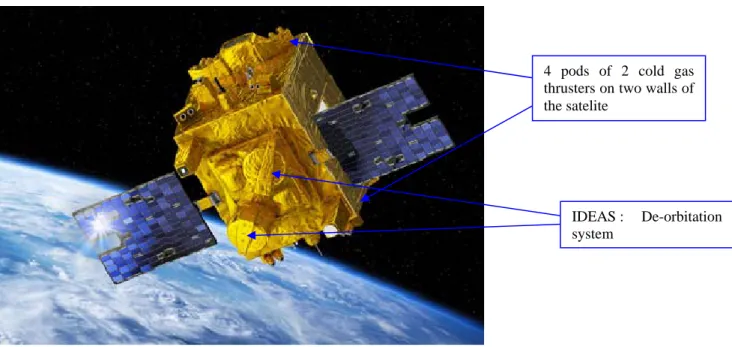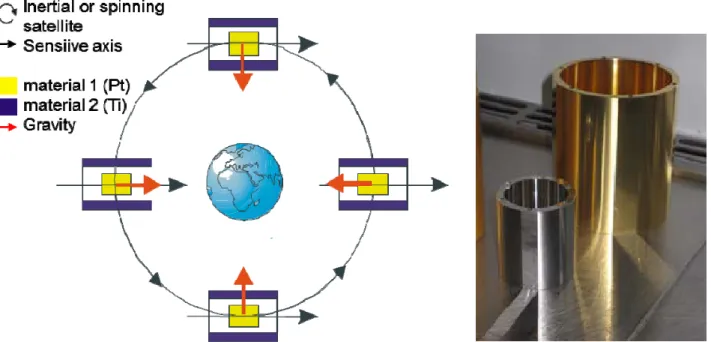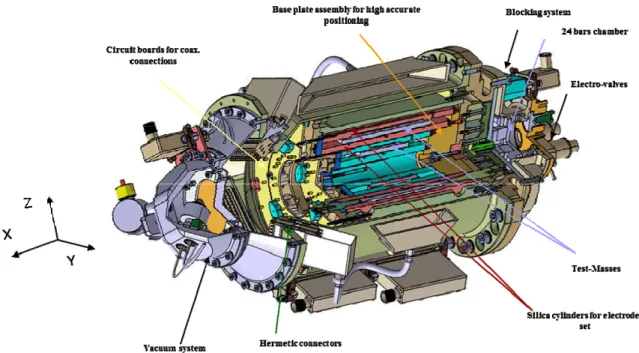HAL Id: hal-01441728
https://hal.archives-ouvertes.fr/hal-01441728
Submitted on 20 Jan 2017HAL is a multi-disciplinary open access archive for the deposit and dissemination of sci-entific research documents, whether they are pub-lished or not. The documents may come from teaching and research institutions in France or abroad, or from public or private research centers.
L’archive ouverte pluridisciplinaire HAL, est destinée au dépôt et à la diffusion de documents scientifiques de niveau recherche, publiés ou non, émanant des établissements d’enseignement et de recherche français ou étrangers, des laboratoires publics ou privés.
MICROSCOPE a micro-satellite for a major corner
stone in fundamental physics, from qualification to
launch
Manuel Rodrigues, Pierre Touboul, Ratana Chhun, Françoise Liorzou, Gilles
Metris
To cite this version:
Manuel Rodrigues, Pierre Touboul, Ratana Chhun, Françoise Liorzou, Gilles Metris. MICROSCOPE a micro-satellite for a major corner stone in fundamental physics, from qualification to launch. Small Satellites, Systems and Services Symposium 2016, May 2016, LA VALETTE, Malta. �hal-01441728�
MICROSCOPE A MICRO-SATELLITE FOR A MAJOR CORNER STONE IN FUNDAMENTAL PHYSICS, FROM QUALIFICATION TO LAUNCH
Manuel Rodrigues (1), Pierre Touboul (2), Ratana Chhun (1), Françoise Liorzou (1), Gilles Metris
(3)
(1)
Physics Department, ONERA, 29 avenue de la division Leclerc, 92320 Chatillon, France,
manuel.rodrigues@onera.fr, +33146734728
(2)
General Scientific Directorate, ONERA, 91123 Palaiseau
(3)
Univ. Nice Sophia Antipolis, CNRS, Observatoire de la Côte d’Azur, Géoazur UMR 7329, 250 rue Albert Einstein, Sophia Antipolis, 06560 Valbonne, France
ABSTRACT
The MICROSCOPE space mission aims at testing the Equivalence Principle with an accuracy of 10-15. To be launched on April 2016, the CNES microsatellite embarks the instrument that should test for the first time in space the foundation of General Relativity. The expected results whether they confirm or not the Equivalence Principle will bring a major constraint on Physics Models trying to unify Gravity and Quantum Physics.
The payload developed by ONERA is composed of two double accelerometers giving full 6-axis measurements to be processed with on-board GPS and star-trackers collected data. The on-ground process of the data takes into account the fine time stamping of the measurement pick up and the position of the satellite along its orbit to correct the Earth’s gravity gradient effect in the difference of the acceleration of two bodies in free-fall. The data once corrected is exploited to extract a potential signal of violation which is along to the Earth’s gravity field.
During 2015, the payload flight model has been intensively tested during the qualification campaign of the satellite: environmental tests, EMC tests, electrical tests…. Major results will be presented. They were computed with the Science Mission Center softwares also under development in ONERA. These data complement the simulated data provided by CNES in order to validate the mission ground segment.
After a general presentation of the instrument and its performance, the paper will emphasize some return on the particular experience of implementing a high accurate instrument in a small satellite such as MICROSCOPE.
As the launch is very close to the presentation, the flight acceptance should be ongoing. A priori no flight data should be available. Nevertheless, the mission flight scenario will be presented as well as the way it will be generated and updated each week by the Mission Center.
1 SCIENTIFIC OBJECTIVES
The Equivalence Principle (EP) is at the base foundation of Einstein’s theory of General Relativity. It stipulates in particular that all bodies, independently of their mass or intrinsic composition, feel the same acceleration in a same uniform gravity field. Tested since Galileo, this principle is today experimentally verified [1] at levels of 10-13.
It means that two bodies free fall in a gravity field and in absence of non gravitational perturbation in the same way when considering the same initial conditions and the difference of acceleration is less than 10-13 times the local gravity.
The sensitivity of ground experiments is mainly limited by the noisy environment in laboratory and the strong local gravity fluctuations. This sensitivity is unfortunately lower than the limit where an eventual violation could be observed as expected for instance in new theories of Quantum Gravity [2]. Enhancing the accuracy to two orders of magnitude that would allow observing a predicted violation by some alternative theories to the General Relativity is therefore crucial to establish the famous Grand Unified Theory.
Experimenting in space offers advantageous conditions compared to the Earth environment: reduced vibrations and unknown gravity gradient fluctuations, very long integration time, highly stable thermal conditions, modulation of the Earth gravity source in the instrument reference frame.
This is what has motivated ONERA (Office National d’Etudes et de Recherches Aérosaptiales) in partnership with OCA (Observatoire de la Cote d’Azur) to propose a space mission fully dedicated to test the EP with an accuracy of 10-15 : MICROSCOPE. This is also the name of the satellite which has been developed by CNES.
MICROSCOPE mission takes advantage of each partner leadership in its respective domain, and gathers a perfect team of high technology and Earth’s gravity modelling members:
- ONERA develops the accelerometers of the three space geodesy missions during the last decades: CHAMP_DLR/CNES, GRACE_DLR/JPL, GOCE_ESA,GRACE-FO_JPL; as for the previous sensors, it considers for the test in free fall of its instrument, the University of Bremen with its drop tower and benefits of the German laboratory PTB for the production of the test-masses;
- OCA is expert in space geodesy ;
- CNES, the French Space Agency has developed a micro-satellite line that enables small scientific space experiments for lower costs than regular agency missions.
In addition to this expertise, CNES has developed in coordination with ONERA and OCA a new satellite attitude and orbit controller. On one hand, with the help of the cold gas micro-thrusters which were first developed for the GAIA mission, and on the other hand, with the help of the accelerometer and the star sensor measurements hybridization, the Satellite Attitude and Acceleration Controller manages accurately the six degrees of freedom.
Figure 1: Microscope satellite : (c) CNES_ill.DUCROS.David_2016
IDEAS : De-orbitation system
4 pods of 2 cold gas thrusters on two walls of the satelite
2 MEASUREMENT PRINCIPLE
The 320kg satellite was developed by CNES within its MYRIAD program of micro-satellite. It takes advantage of existing flight qualified equipment such as the star sensors, the batteries, the solar panels for instance and it allows some technology breakthrough as the drag-free controller or the IDEAS system (de-orbitation system) : Figure 1.
The satellite is maintained in a geodetic trajectory, without orbit control (free-fall), and is injected on a quasi-circular polar orbit (eccentricity < 5 10-3), at 707 km altitude, to provide a very well-known frequency measurement; the orbit is also selected heliosynchronous. This ensures that the side of the satellite exposed to the Sun will always be the same which allows optimal fixed solar panels. It also ensures thermal stability of the satellite sides which is important because the instrument thermal control is passive in order to respect the constraints of low micro-vibration on satellite.
The duration of the mission is planned to be two years while the orbit period is about 6000 s. The time span of one the measurement session, not limited by the free fall, will be superior to 120 orbits. Our laboratory in Onera is in charge of the scientific payload and the scientific control mission center developments.
The objective of the mission is to reproduce the famous “Galileo” experiment of free-fall of two bodies in orbit. Nevertheless, comparing the free-fall of two bodies is a task too much challenging as mainly driven by initial conditions. To cope with these difficulties, we proposed to servo-controlled the position of the two bodies to remain motion-less at 10-10m levels with the “free-falling” satellite. Thus the controlled acceleration applied to the test-mass should be exactly the same if the EP is true but should reveal a small difference if a violation occurs. The Earth is the gravitational source of the EP test. The difference of two measured accelerations is observed along the local Earth’s gravity which is at orbital frequency for a satellite in inertial pointing (Figure 2).
Figure 2: Left: Test of the EP in orbit with MICROSCOPE. Right: Flight models of T-SAGE Test-masses, the small test-mass is made of Pt-Rh10 and the big one in Titanium alloy with gold coating
The environment is maintained very steady limiting any perturbation and the System of Control of Attitude and Acceleration (SCAA) exploits the measurement of the accelerometer in order to make the satellite drag free along the six degrees of freedom (three translations and three rotations): the surface forces and torques applied on the satellite are countered continuously by the thrust of the propulsion system. To this extent, MICROSCOPE represents a technical challenge.
The frequency of the expected EP violation signal is very well known and depends on the relative rate of rotation of the satellite with respect to the Earth: this is the orbital frequency in inertial pointing, and the sum of the orbital frequency and of the spin frequency if the satellite rotates about the normal to orbital plane. The EP frequency can be increased to take advantage of better instrument performances at upper frequencies and better rejection. The maximum considered spin frequency is less than 1 mHz.
3 THE INSTRUMENT
MICROSCOPE embarks only one payload composed of two double accelerometers, called T-SAGE (Twin Space Accelerometer for Gravitation Experiment). Each double accelerometer contains two pairs of test-masses which six degrees of freedom are servo-controlled by electrostatic forces.
The test-masses of the first accelerometer, called REF for reference, are made of the same material: an alloy of platinum (90%) and rhodium. The test-masses of the second one, called EP for Equivalence Principle are made of different materials: platinum-rhodium alloy and gold coated titanium.
For the first accelerometer, no violation of the EP is expected and thus this accelerometer constitutes a reference of null value for the resulting data process. It helps establishing the systematic errors in order to assess the computed results from the EP accelerometer.
The test-masses have been designed with a specific cylindrical shape and optimal sizes to give the same momentum of inertia about all the three axes up to second order, the test-masses behave as spheres. This is much more efficient to test gravity and to reject artefact signals due to difference of the positions of the test-mass centre, capacitively driven (led by geometry) and the centre of gravity (led by mass distribution, inertia momentum and gravity direction).
The electrostatic forces are applied by electrodes grooved on gold coated silica cylinders. The production of these silica cylinders was performed by 4D ultrasonic machining (Onera’s patent).
Figure 3: Sensor unit drawing
The miscentring of the two test-masses of the same accelerometer is the key point of the development of the instrument as it leads to the major perturbative signals. The mechanical core of the instrument has been produced with the best state technologies available and controlled to the micrometer level. Despite the quality of all parts, at the end of the integration process, the two tests masses remain miscentred by 20µm. The Earth gravity gradient coupled to this miscentring generates at EP frequency a signal 100 times larger than the sensitivity required for the mission. This amplitude is proportional to the orbital eccentricity which is specified to 0.005 or less for MICROSCOPE. But the gravity gradient signal of the Earth’s monopole is well known and mainly at two times the EP frequency when the satellite is initially pointing and modulated by the rotation of the satellite when it rotates about the normal of the orbital plane. By knowing also the measurement date to 10ms accuracy and the satellite position (thru the GPS) to a few meters, the gravity can be accurately computed for corrections.
Thanks to the in-flight calibration, the centring is recovered at 0.1µm including border effects of scale factors matching and misalignments. Then, after correction of the gravity effects, the data process can recover a difference of acceleration measurement of less than 8.10-15 ms-2 at EP frequency after 120 orbit integration time.
Beyond mechanics accuracy, electronics has been developed with the microvolt as the key driver. Measuring 8.10-15 ms-2 is also a challenge for the electronics. A particular care was taken to the digital controller composed of an Analog Device DSP TSC21020 and an ACTEL FPGA RT54SX72SU. The combination of these two components is not trivial and their dual operation tested to nanosecond levels within a large range of temperature. The embarked software of the DSP has been developed around an extended 40 bits architecture with 24 bits analog to digital converters and signals stored on 32 bits. The servoloop and the telemetry use 32 bits numbers. It was a complex task to develop the software with components and basis of digitalisation so different and to verify at the end the accuracy of the produced data.
4 QUALIFICATION RESULTS
The payload was delivered to CNES in October 2014. The qualification process specified by CNES requires at the beginning 9grms loads for the random vibrations. Unlike previous accelerometers developed by ONERA, T-SAGE possesses a blocking device in order to handle the 0.3kg to 1.3kg test-masses safely during the launch phase. Once in orbit, the device system is unlocked with a telecommand coming from the ground control center in CNES Toulouse.
This vibration load was a critical point for the mechanical core and in particular for the thin 7µm electrical gold wire, used to connect the test-mass to a very stable voltage source. Two years of development were necessary to understand the breaking process of the gold wire and to correct it. The test-masses are blocked by a pair of three fingers on each side of the test-masses.
The test-mass/fingers system is excited at its resonance (400Hz, 600Hz or 800Hz depending on the mass) and induced a kind of lasso motion to the gold wire which broke.
Figure 4: Left: Integration of the 7µm diameter gold wire (20mm long) between the test-mass and the base plate. Right: Vibration tests of the Flight Model Sensor Unit (Two differential accelerometers)
To solve this problem, it was possible in cooperation with CNES, to add a specific damping device at the payload interface that reduces to 3.5grms the levels of vibration and thus the amplitude of the motion of the gold wire. The integration process was also improved to guarantee a repeatability of the mounting and a better resistance. Before delivery, the qualification model sustained successfully 5 times the vibration duration that would be applied to the flight model from acceptance tests to in orbit operation. This endurance test was quite new for us and very demanding with respect to such a sensitive payload.
The levels of vibrations were less critical to sustain for the electronics, and no endurance tests were necessary.
5 DATA PROCESS
Since the delivery of the flight model, we have been developing the Science Mission Center. The tasks of the Science Mission Center are:
- To collect the data from the files server in CNES - To store and organize the data for analysis
- To evaluate each day the good “health” of the instrument and the good operation of the mission scenario
- To process the data for the science objectives (in-flight calibration, data correction, filtering, EP evaluation)
- To manage the mission scenario
- To archive and to distribute the data after the end of the mission.
This led to develop two types of software: operational and scientific ones.
The operational software is in interface with CNES responsible of the ground segment. They have been intensively tested for more than one year with simulated data provided by CNES. The hardware needed for the operations are servers that have sufficient capacity to store all the mission rough data and processed data and that have enough reliability during the 3-year mission including possible extension and 5-year period of data distribution.
The science software has been also tested with the CNES simulated data, to perform a blind test. The following table shows the first data process results:
Parameter to be recovered Value of the hinted parameter Result of the data process
Miscentring along X -33.0µm -33.9µm
Miscentring along Y +17 µm +16 µm
Miscentring along Z +26.0µm +25.0µm
Table 1: Results of the mission center calculation on the basis of a specific mission scenario simulated by CNES. The data were processed with the software developed in the Mission Science Center in ONERA.
The results show in table 1 a 1µm error instead of the 0.1µm: this is due to the non-calibrated scale factors here. When taking into account the calibration, the results are much better (obtained with the science software modules before integration in the mission center) [3]. The integration of all science modules is actually performed and should be validated in the few following weeks, before the start of the science phase foreseen in August 2016.
6 CONCLUSION
The MICROSCOPE satellite must be launched in April 2016. From April to mid June 2016, the commissioning phase should state on the good heath of the satellite and all its subsystems including the payload developed by ONERA and the drag-free controller. From June to end of July 2016, the satellite will be in pause because of a period of eclipses. At end of July, the satellite will be awaken with the payload. Then, the science should start with ideal thermal conditions for nine months. After preliminary performances tests, the calibration phase will be performed and then the EP tests in several configuration of the satellite (inertial pointing, two rotation frequencies of the spin).
In January 2017, a first science Phase should be completed and give a first taste of violation or not. The performance of the experiment and the evaluation of the bar of systematic errors should be available in 24monts to consolidate the levels of 10-15 sensitivity.
7 ACKNOWLEDGEMENTS
The authors want to acknowledge the CNES for their support and funding to develop the payload, OCA (Nice, France) for their contribution to the mission analysis and performance, the PTB for their contribution thru DLR to the development of the flight model test-masses, the ZARM for their contribution to the qualification and acceptance tests of the payload in free-fall. Part of the work is
funded by ONERA.
8 REFERENCES
[1] Schlamminger, S., Choi, K., Wagner, T.A. et al. 2008, Phys. Rev. Letter, 100, 041101
[2] Damour, T., Piazza, F., Venezziano, G. 2002, Phys. Rev. D, 046007.
[3] Baghi, Q, Metris G., Berge J., Christophe B., Touboul P., Rodrigues M.,; Phys. Rev. D, 91(062003), 2015.



